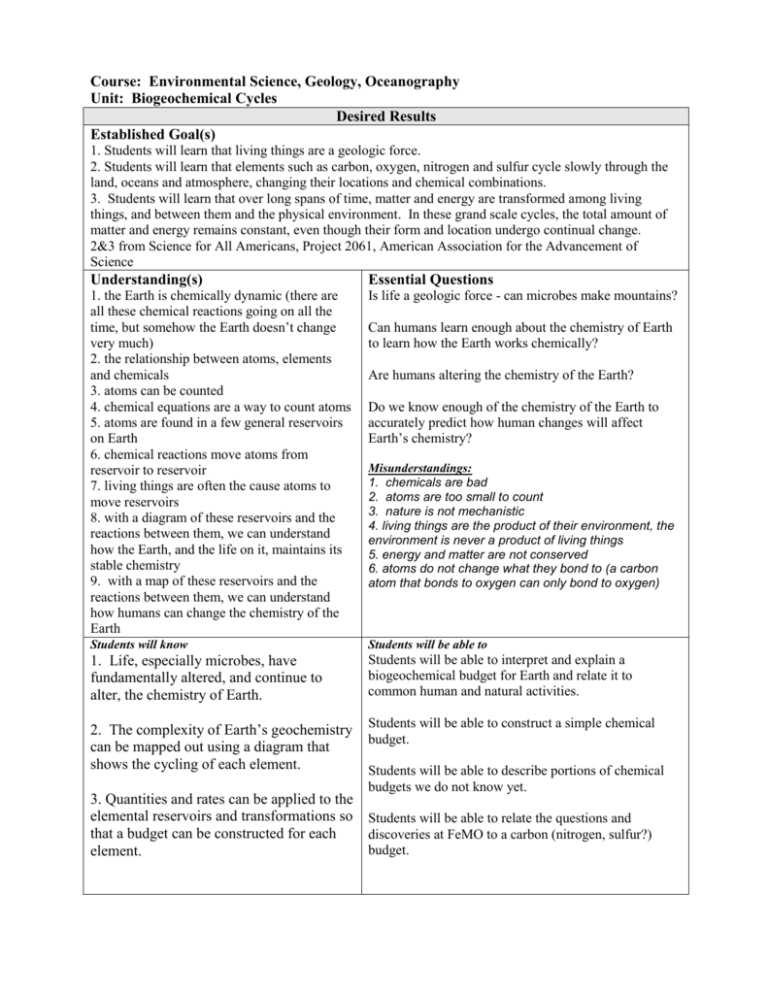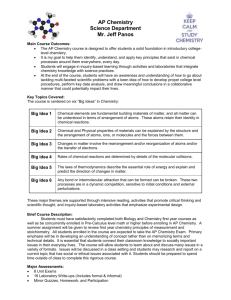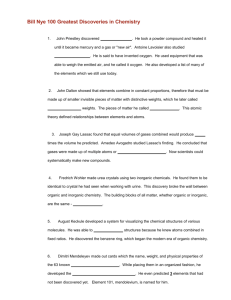Course:
advertisement

Course: Environmental Science, Geology, Oceanography Unit: Biogeochemical Cycles Desired Results Established Goal(s) 1. Students will learn that living things are a geologic force. 2. Students will learn that elements such as carbon, oxygen, nitrogen and sulfur cycle slowly through the land, oceans and atmosphere, changing their locations and chemical combinations. 3. Students will learn that over long spans of time, matter and energy are transformed among living things, and between them and the physical environment. In these grand scale cycles, the total amount of matter and energy remains constant, even though their form and location undergo continual change. 2&3 from Science for All Americans, Project 2061, American Association for the Advancement of Science Understanding(s) Essential Questions 1. the Earth is chemically dynamic (there are all these chemical reactions going on all the time, but somehow the Earth doesn’t change very much) 2. the relationship between atoms, elements and chemicals 3. atoms can be counted 4. chemical equations are a way to count atoms 5. atoms are found in a few general reservoirs on Earth 6. chemical reactions move atoms from reservoir to reservoir 7. living things are often the cause atoms to move reservoirs 8. with a diagram of these reservoirs and the reactions between them, we can understand how the Earth, and the life on it, maintains its stable chemistry 9. with a map of these reservoirs and the reactions between them, we can understand how humans can change the chemistry of the Earth Is life a geologic force - can microbes make mountains? Students will know Students will be able to 1. Life, especially microbes, have fundamentally altered, and continue to alter, the chemistry of Earth. Students will be able to interpret and explain a biogeochemical budget for Earth and relate it to common human and natural activities. 2. The complexity of Earth’s geochemistry can be mapped out using a diagram that shows the cycling of each element. Students will be able to construct a simple chemical budget. Can humans learn enough about the chemistry of Earth to learn how the Earth works chemically? Are humans altering the chemistry of the Earth? Do we know enough of the chemistry of the Earth to accurately predict how human changes will affect Earth’s chemistry? Misunderstandings: 1. chemicals are bad 2. atoms are too small to count 3. nature is not mechanistic 4. living things are the product of their environment, the environment is never a product of living things 5. energy and matter are not conserved 6. atoms do not change what they bond to (a carbon atom that bonds to oxygen can only bond to oxygen) Students will be able to describe portions of chemical budgets we do not know yet. 3. Quantities and rates can be applied to the elemental reservoirs and transformations so Students will be able to relate the questions and that a budget can be constructed for each discoveries at FeMO to a carbon (nitrogen, sulfur?) budget. element. Assessment Evidence Performance Task(s) 1. Students construct a budget using their allowance. 2. Students balance a blank carbon budget. 3. Students write a paragraph explaining how to balance a budget diagram. 4. Students mark photosynthesis arrow with a “P”, respiration arrow with an “R” and circle human caused arrows. 5. Students write 2 questions about carbon budget in their journals. 6. Using rate data for 5 arrows, students calculate rates for 3 arrows missing data. 7. Student responses: - how much carbon are humans adding to the atmosphere each year? - name and explain the arrow that has the best chance of removing the excess atmospheric carbon. - explain things that humans are doing that might make it more difficult for the excess atmospheric carbon to be removed. 8. Student paragraph explaining the route of a single carbon atom through the 4 reservoirs of the carbon cycle. 9. Student discussion notes: Do we expect the carbon cycle to change in the future? Was the carbon cycle different in the ancient past? Do other elements cycle like carbon? example? Key Criteria: Other Evidence Learning Plan Learning Strategies and Resources









